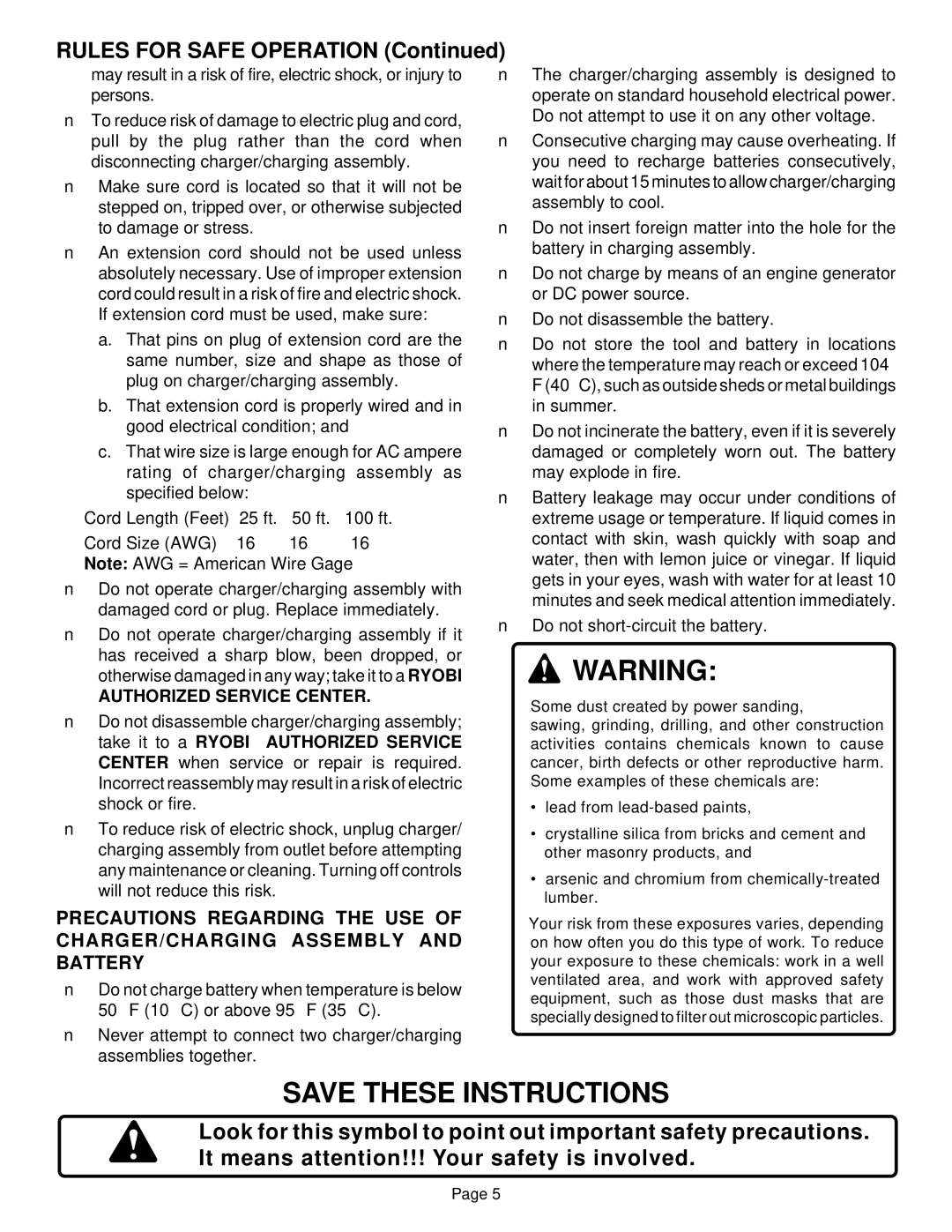
RULES FOR SAFE OPERATION (Continued)
may result in a risk of fire, electric shock, or injury to persons.
■To reduce risk of damage to electric plug and cord, pull by the plug rather than the cord when disconnecting charger/charging assembly.
■Make sure cord is located so that it will not be stepped on, tripped over, or otherwise subjected to damage or stress.
■An extension cord should not be used unless absolutely necessary. Use of improper extension cord could result in a risk of fire and electric shock. If extension cord must be used, make sure:
a.That pins on plug of extension cord are the same number, size and shape as those of plug on charger/charging assembly.
b.That extension cord is properly wired and in good electrical condition; and
c.That wire size is large enough for AC ampere rating of charger/charging assembly as specified below:
Cord Length (Feet) | 25 ft. | 50 ft. | 100 ft. |
Cord Size (AWG) | 16 | 16 | 16 |
Note: AWG = American Wire Gage
■Do not operate charger/charging assembly with damaged cord or plug. Replace immediately.
■Do not operate charger/charging assembly if it has received a sharp blow, been dropped, or otherwise damaged in any way; take it to a RYOBI
AUTHORIZED SERVICE CENTER.
■Do not disassemble charger/charging assembly; take it to a RYOBI AUTHORIZED SERVICE CENTER when service or repair is required. Incorrect reassembly may result in a risk of electric shock or fire.
■To reduce risk of electric shock, unplug charger/ charging assembly from outlet before attempting any maintenance or cleaning. Turning off controls will not reduce this risk.
PRECAUTIONS REGARDING THE USE OF CHARGER/CHARGING ASSEMBLY AND BATTERY
■Do not charge battery when temperature is below 50° F (10° C) or above 95° F (35° C).
■Never attempt to connect two charger/charging assemblies together.
■The charger/charging assembly is designed to operate on standard household electrical power. Do not attempt to use it on any other voltage.
■Consecutive charging may cause overheating. If you need to recharge batteries consecutively, wait for about 15 minutes to allow charger/charging assembly to cool.
■Do not insert foreign matter into the hole for the battery in charging assembly.
■Do not charge by means of an engine generator or DC power source.
■Do not disassemble the battery.
■Do not store the tool and battery in locations where the temperature may reach or exceed 104° F (40° C), such as outside sheds or metal buildings in summer.
■Do not incinerate the battery, even if it is severely damaged or completely worn out. The battery may explode in fire.
■Battery leakage may occur under conditions of extreme usage or temperature. If liquid comes in contact with skin, wash quickly with soap and water, then with lemon juice or vinegar. If liquid gets in your eyes, wash with water for at least 10 minutes and seek medical attention immediately.
■Do not
![]() WARNING:
WARNING:
Some dust created by power sanding,
sawing, grinding, drilling, and other construction activities contains chemicals known to cause cancer, birth defects or other reproductive harm. Some examples of these chemicals are:
•lead from
•crystalline silica from bricks and cement and other masonry products, and
•arsenic and chromium from
Your risk from these exposures varies, depending on how often you do this type of work. To reduce your exposure to these chemicals: work in a well ventilated area, and work with approved safety equipment, such as those dust masks that are specially designed to filter out microscopic particles.
SAVE THESE INSTRUCTIONS
Look for this symbol to point out important safety precautions. It means attention!!! Your safety is involved.
Page 5
